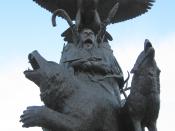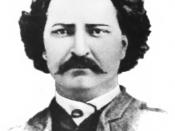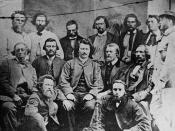Louis Riel, who lived from 1844 to 1885, was a Canadien Metis born in Manitoba. The Metis were people of mixed French and Indian ancestry. Riel is known for being the driving force behind two rebellions, in 1870 and 1885, in which he fought to protect the property, cultural, religious, and language rights of the Metis. He was a gentle, religious man whose name became associated with violence although he himself never took up arms. Although Riel was hanged as a traitor, he is presently viewed by some as a champion of minority rights.
The North-West Rebellion ended with Riel's death. Few events led up to this rebellion. The main cause was the Canadian government trying to populate the Metis' land in the Saskatchewan River Valley with English settlers. Earlier, in Manitoba, the Red River Rebellion had been caused by similar actions by the government. Now, in 1872, the government of Canada opened the territory around the Saskatchewan River to white settlers from the east, causing the Metis way of life to be threatened again.
The Metis wrote a petition and sent it to Ottawa, but they were disappointed with the weak response. Frustrated, they again turned to Louis Riel.
The Metis protests soon led to armed rebellion, known as the North-West Rebellion. On March 19, 1885, under Riel's leadership, the Metis proclaimed the Provisional Government of Saskatchewan and Batoche. The Canadian government regarded this as a step of treason and sent government troops. These troops, along with some North-West Mounted Police and local volunteers, soon moved against the Metis at Batoche. The Metis and their Indian allies were seriously outnumbered and poorly equipped, and were quickly defeated in May 1885. Although the Metis military leader, Gabriel Dumont, escaped to the United States, Riel gave himself up. Unfortunately, the...


